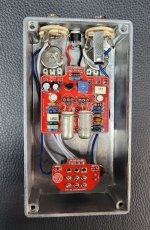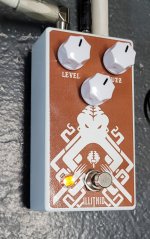VanWhy
Well-known member
- Build Rating
- 5.00 star(s)
I've been really into "hybrid" fuzzes recently and this one piqued my interest. So for those unfamiliar here is the description from EL:
"The ILLITHID is a hybrid silicon/germanium/MOSFET fuzz based on the 3-knob Dunwich Cthulhu Fuzz. The first stage is essentially a Fuzz Face with a pot panning between 2 different input caps, along with a MOSFET stacked on a germanium transistor. This is fed into a modified Big Muff gain stage with germanium and LED clipping."
Yes please. So backstory is I tried to build this about a month and a half ago. Wouldn't work at first so during troubleshooting I pulled up a couple pads and really butchered it. It was a mess. I had a couple other of EL boards that couldn't get working so I just bagged this board. I really like what I did with the enclosure so I ended up just ordering another board. Let it sit for a while then I saw @Fuzzonaut post his build and saw he did it a little different so that inspired me to get thing going again. Redid the board and finally fired right up. Reused the enclosure and I really like how it came out. The enclosure has some scuffs, etc from sitting around and getting shuffled around but other than that it's fine with me.
This does sound pretty cool. It's interesting how it uses Mosfet, Ge, and LED clipping. Pretty fun. Glad I finally finished it.
"The ILLITHID is a hybrid silicon/germanium/MOSFET fuzz based on the 3-knob Dunwich Cthulhu Fuzz. The first stage is essentially a Fuzz Face with a pot panning between 2 different input caps, along with a MOSFET stacked on a germanium transistor. This is fed into a modified Big Muff gain stage with germanium and LED clipping."
Yes please. So backstory is I tried to build this about a month and a half ago. Wouldn't work at first so during troubleshooting I pulled up a couple pads and really butchered it. It was a mess. I had a couple other of EL boards that couldn't get working so I just bagged this board. I really like what I did with the enclosure so I ended up just ordering another board. Let it sit for a while then I saw @Fuzzonaut post his build and saw he did it a little different so that inspired me to get thing going again. Redid the board and finally fired right up. Reused the enclosure and I really like how it came out. The enclosure has some scuffs, etc from sitting around and getting shuffled around but other than that it's fine with me.
This does sound pretty cool. It's interesting how it uses Mosfet, Ge, and LED clipping. Pretty fun. Glad I finally finished it.



